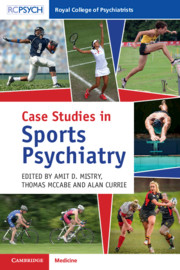Book contents
- Case Studies in Sports Psychiatry
- Reviews
- Case Studies in Sports Psychiatry
- Copyright page
- Contents
- Editors
- Contributors
- Foreword
- Preface
- Chapter 1 American Football: Cognitive Impairment
- Chapter 2 Athletics: Energy Levels, Exercise Addiction and Disordered Eating
- Chapter 3 Boxing: Low Mood and Gambling
- Chapter 4 Cricket: Mental Health Emergencies
- Chapter 5 Cycling: Attention Deficit Hyperactivity Disorder and Anti-Doping
- Chapter 6 Football: Alcohol and Barriers to Support
- Chapter 7 Golf: Alcohol, Anxiety and Sleep Problems
- Chapter 8 Rugby: Concussion and Mental Health Symptoms
- Chapter 9 Swimming: Adolescent Athlete Training Commitments
- Chapter 10 Tennis: Trauma and Tours
- Appendix: International Society for Sports Psychiatry Curriculum 2018
- Index
- Plate Section
- References
Chapter 1 - American Football: Cognitive Impairment
Published online by Cambridge University Press: 29 July 2020
- Case Studies in Sports Psychiatry
- Reviews
- Case Studies in Sports Psychiatry
- Copyright page
- Contents
- Editors
- Contributors
- Foreword
- Preface
- Chapter 1 American Football: Cognitive Impairment
- Chapter 2 Athletics: Energy Levels, Exercise Addiction and Disordered Eating
- Chapter 3 Boxing: Low Mood and Gambling
- Chapter 4 Cricket: Mental Health Emergencies
- Chapter 5 Cycling: Attention Deficit Hyperactivity Disorder and Anti-Doping
- Chapter 6 Football: Alcohol and Barriers to Support
- Chapter 7 Golf: Alcohol, Anxiety and Sleep Problems
- Chapter 8 Rugby: Concussion and Mental Health Symptoms
- Chapter 9 Swimming: Adolescent Athlete Training Commitments
- Chapter 10 Tennis: Trauma and Tours
- Appendix: International Society for Sports Psychiatry Curriculum 2018
- Index
- Plate Section
- References
Summary
FB is a 53-year-old Caucasian male living in the USA. He had played professional football in the NFL until his thirties and in retirement had worked as a coach. He has two grown up children who have now left home. He is not currently working and lives with his wife of 28 years. He was initially reviewed by his family doctor in response to his wife’s concerns. Although his participation in this initial consultation was minimal it was noted that his personality seemed to have coarsened and there were significant changes in his behaviour. As a result he was referred to a psychiatrist for a more detailed assessment. He only agreed to attend this assessment after much encouragement from his family and friends although he had admitted privately to a friend that ‘something was not quite right’. The report from this psychiatric assessment is set out below.
- Type
- Chapter
- Information
- Case Studies in Sports Psychiatry , pp. 1 - 14Publisher: Cambridge University PressPrint publication year: 2020



